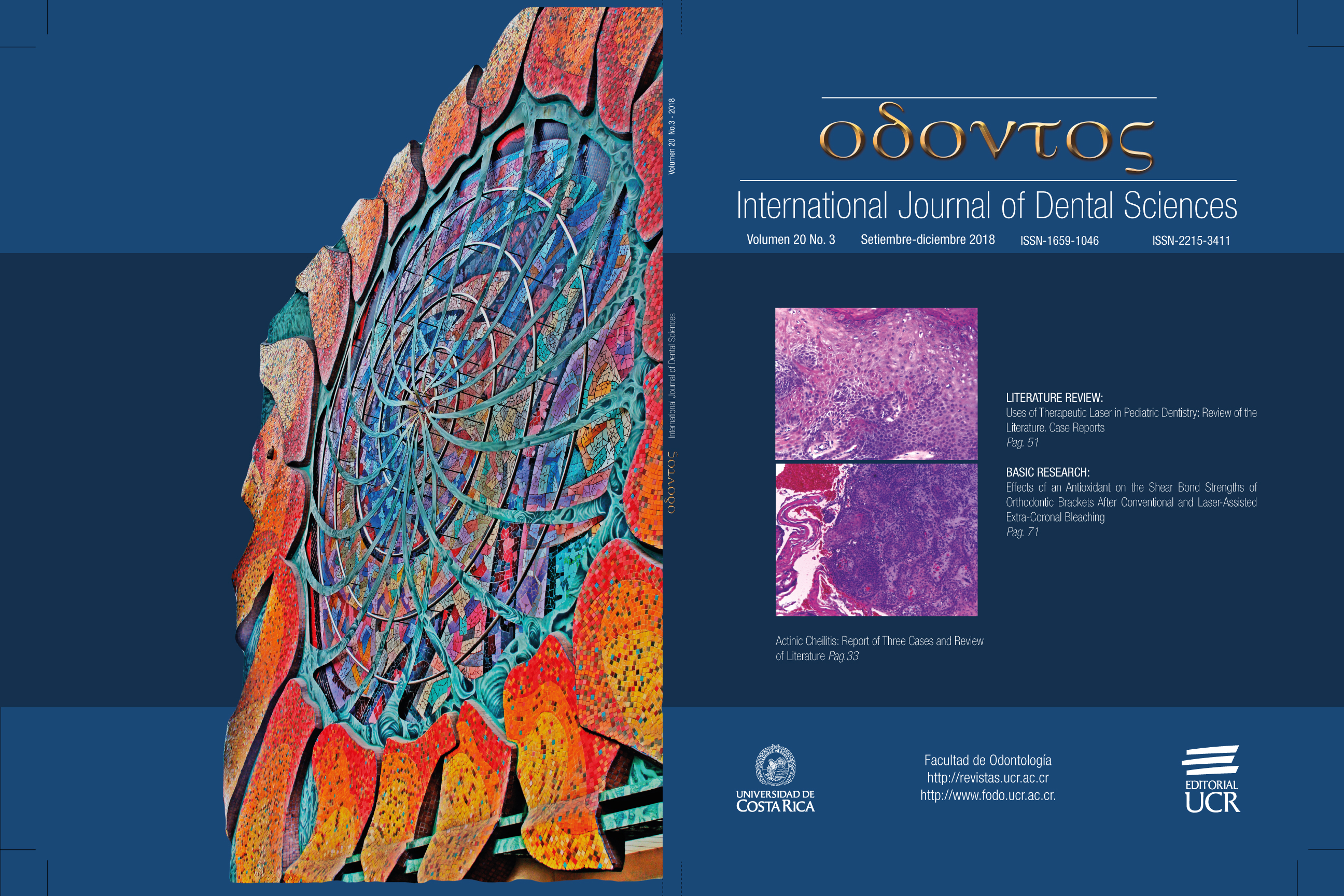Resumen
Caries is one of the diseases of infectious nature, chronic transmissible very prevalent in Peru, related to the presence of Streptococcus mutans, hygienic and nutritional habits. Objective: The purpose of this study was to determine the presence of genotype C in Streptococcus mutans in Peruvian children and adolescents, using the PCR-Multiplex technique; and its association with the prevalence of dental caries. Materials and methods: The study was done with a sample of 78 children and adolescents of both sexes from Lima. The study consisted of two phases, on the first one the stimulated saliva was obtained, for the bacterial culture, the same ones that were grown on Mitis Salivarius agar with bacitracin and sulfisoxasol. On the second phase, genotyping was carried out according to its enzymatic profile. For the extraction of DNA, the Gene Extraction Kit GG-1 Bacterial DNA was used, for which cultures of Streptococcus sp strains were performed in the BHI broth with sucrose at 37ºC for 24 hours. Results: The presence of Streptococcus mutans was evidenced in 59 (75.6%) of 78 saliva samples. The results of the genotyping by PCR Multiplex demonstrate the presence of 22 saliva samples of Streptococcus mutans with genotypes C (37,297%) and 37 samples 62, 71 % without this Genotype. Conclusions: The results showed that the presence of genotype C is not related to sex, age group or the presence of dental caries.
Citas
Ministerio de Salud del Perú. Oficina General de Epidemiología y Dirección General de Salud de las Personas. Prevalencia Nacional de Caries dental, fluorosis del esmalte y urgencia de tratamiento en escolares de 6 a 8, 10, 12 y 15 años. Perú, (2005), [citado abril 8,2017] .Disponible en: https://www.minsa.gob.pe/portalweb/06prevencion/prevencion_2.asp?sub5=13
Gamboa F. Identificación y caracterización microbiológica, fenotípica y genotípica del Streptococcus mutans: experiencias de investigación. Uni Odontol. 2014 Jul-Dic; 33 (71): 65-73. http://dx.doi.org/10.11144/Javeriana
Ojeda G. J. C., Oviedo G. E., Salas L. A. Streptococcus mutans and dental caries. Revista CES Odontología ISSN 0120-971X Volumen 26 No. 1 Primer Semestre de 2013.
Ikeda T., Ochiai K., Shiota T. Taxonomy of the oral Streptococcus mutans based on colonial characteristics and serological, biochemical and genetic features. Arch Oral Biol. 1979; 24 (10,11): 863-867.
Burne R. Oral streptococci Products of their environment. J Dent Res. 1998; 77 (3): 445-452.
Koo H., Xiao J., Klein M., Jeon J. Exopolysaccharides produced by Streptococcus mutans glucosyltransferases modulate the establishment of microcolonies within multispecies biofilms. J Bacteriol. 2010; 192 (12): 3024-3032.
Busuioc M., Mackiewicz K., Buttaro B., Piggot P. Role of intracellular polysaccharide in persistence of Streptococcus mutans. J Bacteriol. 2009; 191 (23): 7315-7322.
Nakano K., Nomura R., Nakagawa I., Hamada S., Ooshima T. Demonstration of Streptococcus mutans with a cell wall polysaccharide specific to a new serotype k, in the human oral cavity. J Clin Microbiol. 2004 Jan; 42 (1): 198-202.
Nakano K., Nomura R., Shimizu N., Nakagawa I., Hamada S., Ooshima T. Development of a PCR method for rapid identification of new Streptococcus mutans serotype k strains. J Clin Microbiol. 2004; 42 (11): 4925-4930.
Pieralisi F. J., Rodrigues M. R., Segura V. G., Maciel, S., Ferreira, F. B., Garcia, J., & Poli-Frederico, R. Genotypic Diversity of Streptococcus mutans in Caries-Free and Caries-Active Preschool Children. International Journal of Dentistry, 2010, 824976.
Cheon K., Moser S., Wiener H., Whiddon J., Momeni S., Childers N, et al. Characteristics of Streptococcus mutans genotypes and dental caries in children. European Journal of Oral Sciences [serial on the Internet]. (2013, May), [citado Abril10, 2017]; 121 (3pt1): 148-155.
Arévalo M., Canacuán F., Echeverry J., Salazar C., Martínez C., Martínez M. & Correa M. Identificación molecular y genotipificación de Streptococcus mutans de muestras de saliva de niños de Medellín, Colombia. CES odontol. [Internet]. 2014 Dec [cited 2018 July 06]; 27(2): 47-60. Available from: http://www.scielo.org.co/scielo.php?script=sci_arttext&pid=S0120-971X2014000200005&lng=en
Argandoña R., Duque C., Sampaio K., Rodrigues V., de Aguilar M. L., Colombo N., Arthur R., de Cassia T., Gomez F., Botazzo A. Genotypic diversity and phenotypic traits of Streptococcus mutans isolates and their relation to severity of early childhood caries. BMC Oral Health (2017) 17:115.
Pedraza Sánchez D. M., Hernández Velandia Y. A. Diseño y valoración de un medio de cultivo selectivo (SULBAC) para Streptococcus mutans [Trabajo para obtener el título de Bacteriologo]. [Bogota (Colombia)]: Pontificia Universidad Javeriana, Facultad de Ciencias, Carrera de Bacteriología; 2006.
Oho T., Yamashita Y., Shimazaki Y., Kushiyama M., Koga T. Simple and rapid detection of Streptococcus mutans and Streptococcus sobrinus in human saliva by polymerase chain reaction. Oral Microbiol Immunol. 2000; 15: 258-262.
Padilla B. M. Streptococcus mutans en saliva y su relación con caries dental. Unidad Académica de Odontología. México. UAZ, 2009: 55 (6) 48-5.
Hoshino T., Kawaguchi M., Shimizu N., Hoshino N., Ooshima T., Fujiwara T. PCR detection and identification of oral streptococci in saliva samples using gtf genes. Diagn Microbiol Infect Dis. 2004 Mar; 48 (3): 195-9. https://www.ncbi.nlm.nih.gov/pubmed/15023429
Liébana J. Genotipos de Streptococcus mutans de saliva y placa en escolares usando la técnica AP-PCR y el cebador OPA-2. Tesis doctoral. Universidad de Granada 2007. Editorial de la Universidad de Granada. ISBN: 978-84-338-4285-5.
Salazar L. A., Vásquez C., Almuna A., Oporto G., Santana R., Herrera C. L., Sanhueza A. Detección molecular de estreptococos cariogénicos en saliva. Molecular detection of cariogenic streptococcus in saliva. Int. J. Morphol. [internet] dic. 2008 [citado 2017 octubre 22] 26 (4): 951.
Sánchez-Pérez L., Acosta G. E. Estreptococos cariogénicos predominantes, niveles de infección e incidencia de caries en escolares. Revista ADM 2007; 54 (2): 45-51.
Graciano M., Correa Y., Martínez C., Burgos A., Ceballos J., Sánchez L. Streptococcus mutans y caries dental en América Latina. Revisión sistemática de la literatura. Revista Nacional de Odontología. Rev. Cubana Estomatol v.37 n.3 Ciudad de La Habana sep.-dic. 2000.
Gispert E., Rivero A. y Cantillo E. Relación entre el grado de infección por Streptococcus mutans y la posterior actividad cariogénica. Centro Provincial de Investigaciones Estomatológicas. Ciudad de La Habana. vol 8 n° 14 2012.
Welsh J., McClelland M. Fingerprinting genomes using PCR with arbitrary primers. Nucleic Acids Research. 1990; 18 (24): 7213-7218.

